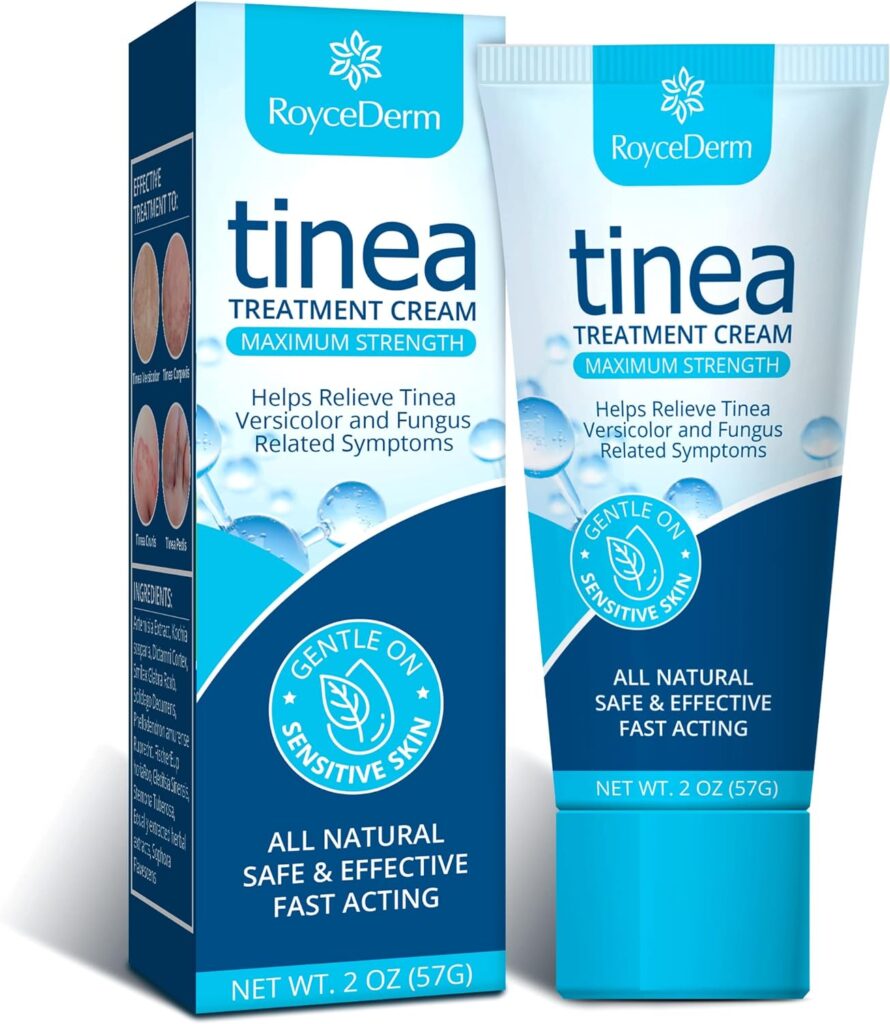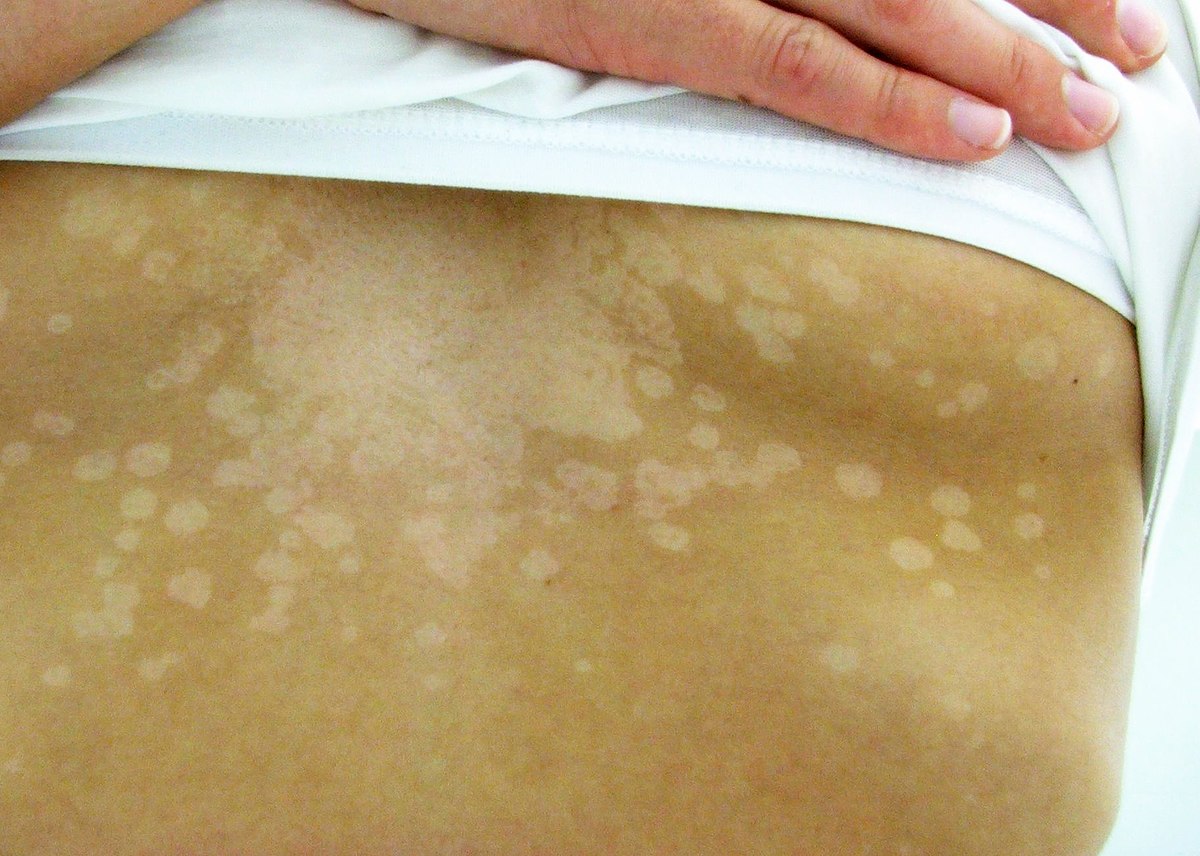OVERVIEW
Pityriasis versicolor, also known as tinea versicolor, is a common fungal skin infection. It is caused by yeast and is characterized by flaky, discolored patches that typically appear on the chest and back.
Tinea versicolor (TIN-ee-uh vur-si-KUL-ur) is most common in teenagers and young adults. Sun exposure can make the condition more noticeable. Also known as pityriasis versicolor, this condition is neither painful nor contagious but can cause emotional distress or self-consciousness.
Antifungal creams, lotions, or shampoos can effectively treat tinea versicolor. However, even after successful treatment, skin color may remain uneven for several weeks or months. The condition often recurs, especially in warm, humid weather.
Characteristics:
- Appearance: The infection causes patches of skin that may be lighter or darker than the surrounding area. These patches can be pink, red, tan, or brown, hence the name “versicolor,” which means “varied color.”
- Location: Commonly found on the chest and back, but can also affect other areas of the body.
Terminology:
- Pityriasis: Refers to skin conditions where the scale resembles bran.
- Tinea: Generally used for dermatophyte fungus infections, though it is sometimes used interchangeably with pityriasis versicolor.
Who Gets Tinea Versicolor?
Tinea versicolor affects many people worldwide, but the exact reasons why yeast overgrows on some people’s skin and not others are unclear. Individuals living in tropical or subtropical regions are at the highest risk for tinea versicolor. It is more common during the summer months in temperate climates and around puberty when the skin’s oil glands are more active.
Certain factors can increase the risk of developing tinea versicolor, including:
- Weak Immune System: People with weakened immune systems, such as those taking corticosteroids or living with conditions like diabetes, are more susceptible.
- Hormonal Changes: Pregnancy can make individuals more prone to tinea versicolor due to hormonal fluctuations.
Overall, while tinea versicolor can affect anyone, these factors may elevate the likelihood of its occurrence.

Symptoms and Causes of Tinea Versicolor
Symptoms:
Tinea versicolor typically presents with mild symptoms, which may include:
- Skin Discoloration: Patches of skin on the back, chest, abdomen, neck, and upper arms that appear lighter or darker than usual. These patches can range in color from pink, yellow, brown, tan, to white.
- Mild Itching: Itching around the affected areas of the skin.
- Scaling: Areas of the skin that may develop scales or become flaky.
- Excessive Sweating: Some individuals may experience increased sweating in affected areas.
- Patches that do not Tan: Affected skin patches do not darken or tan in the sun like the surrounding skin.
Causes:
Tinea versicolor is caused by a type of yeast called Malassezia, which is normally found on the skin’s surface and is usually harmless. Factors that contribute to the development of tinea versicolor include:
- Warm and Humid Environments: These conditions create an ideal environment for the yeast to grow and multiply excessively.
- Oily Skin: Increased activity of the skin’s oil glands, often occurring during puberty or in warm climates, can contribute to yeast overgrowth.
- Weakened Immune System: Conditions such as diabetes, immunosuppressive therapies, or pregnancy can weaken the immune system, making individuals more susceptible to fungal infections.
Overall, tinea versicolor is not contagious and is typically manageable with antifungal treatments, although it may recur, especially in warm weather.
Diagnosis and Tests for Tinea Versicolor
Tinea versicolor diagnosed?
Healthcare providers diagnose tinea versicolor through straightforward skin tests. One method involves scraping off suspected infected skin cells, which are then examined under a microscope for yeast cells.
Another diagnostic tool is the Wood lamp, which uses ultraviolet (UV) light to illuminate the skin. Areas affected by tinea versicolor appear yellow-green under this light.
Management and Treatment of Tinea Versicolor

Tinea versicolor treatment
Tinea versicolor is typically manageable with topical treatments such as creams, lotions, or shampoos containing antifungal agents. For more severe cases, oral antifungal medications may be prescribed to eradicate the fungus and prevent recurrence.
Over-the-counter antifungal medication:
Mild cases of tinea versicolor often respond well to over-the-counter options, including:
- Clotrimazole (Lotrimin AF®)
- Miconazole (Micaderm®)
- Selenium sulfide (Selsun Blue® shampoo)
- Terbinafine (Lamisil AT®)
- Zinc pyrithione soap
Prescription antifungal medication:
For more stubborn cases, doctors may recommend stronger topical antifungal medications such as:
- Ketoconazole (Nizoral® or Extina®)
- Ciclopirox (Loprox® or Penlac®)
In severe instances, oral antifungals like:
- Fluconazole (Diflucan®)
- Itraconazole (Onmel® or Sporanox®)
may be necessary.
Home Treatment for Tinea Versicolor

How can I treat tinea versicolor at home?
Dandruff shampoos containing selenium can be effective. Apply the shampoo to affected areas during showers, leave it on for several minutes, and then rinse thoroughly. Over-the-counter antifungal medications are also available, but consult a healthcare provider if symptoms persist.
Natural remedies are not typically recommended due to limited scientific support.
Untreated Consequences and Duration
What happens if tinea versicolor is left untreated?
While not typically serious, untreated tinea versicolor can lead to worsening symptoms like increased skin discoloration and itching.
How long does tinea versicolor take to go away?
With proper treatment, tinea versicolor usually clears up easily. Skin color may normalize over several weeks to months. Recurrence is common, especially in warm weather.
Prevention of Tinea Versicolor
How can I prevent tinea versicolor?
Preventative measures include using soaps containing zinc pyrithione, ketoconazole, or selenium sulfide during summer months when tinea versicolor is more likely to recur. Avoiding excessive sweating, sunlight exposure, and wearing loose-fitting clothing can also reduce risk.
By following these guidelines, individuals can effectively manage and prevent tinea versicolor outbreaks.
